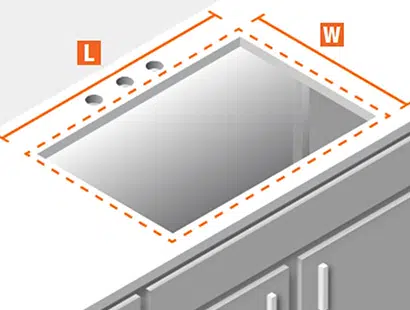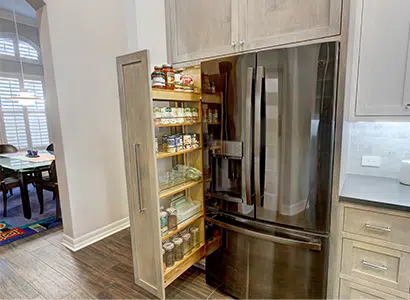Full overlay vs partial overlay, which one is better often becomes a difficult choice for homeowners when they want to choose cabinets. There are some differences between these two covering methods in terms of cost, function, aesthetics, etc. But which is better? Below, we will compare all aspects of these two cabinet covering methods to help you make the choice that best matches your kitchen cabinets.
Definition of Cabinet Overlay
Cabinet overlay is the area of the cabinet door that overlaps the cabinet door frame, and can have a considerable effect on the overall appearance of the kitchen, functional storage space, access to items, and the total cost of the cabinet itself.
Definition of Full Overlay Cabinetry
Full coverage means that the cabinet door and the cabinet door frame are almost completely covered. The cabinet door and the cabinet frame are almost completely fitted together, leaving only a very small gap between the cabinet doors (usually 1/8 inch to 1/4 inch), giving the entire cabinet a seamless appearance.
What is Partial Overlay Cabinetry
Partial overlay means that except for a half-inch to one-inch gap between the cabinet door and the frame, the rest of the frame will be covered by the cabinet door. This cabinet overlay style is a common choice for many families.
Differences between Full Overlay Cabinets and Partial Overlay
Full Overlay cabinets
- Construction Features
The size of the cabinet door is fully concealed by the entire door frame, and often uses concealed European hinges, so some precision alignment is needed during installation. Cabinet doors also typically have a soft-close feature.
- Aesthetic Advantages
The flush frame creates a smooth appearance that makes the kitchen look larger and more open; it works well with the handle-less (push-to-open) style, and the flush surface of the cabinet doors creates an eye-catching design aesthetic.
- Functional Advantages
Full overlay can maximize the use of interior space and eliminate the gap between the door and the doorframe that attracts dust accumulation, and offers a cleaner and easier to maintain overall appearance for your cabinet.
- Potential Disadvantages
Full overlay cabinets are typically higher-priced at the time (usually 15-25% higher than partial overlay);
Does requires better alignment of the wall and the cabinet during the installation.
Wear at the edge of the door may be more visible;
Has less tolerance for less-than-ideal wall conditions.
- Applications
Modern kitchen design;
Small kitchen, visual continuity can expand space;
High-end decoration, appealing focus on high-end appearance;
Minimalist design, emphasizing clean lines.
Partial Overlay Cabinets
- Construction Characteristics
Partial overlay cabinets use a partially covered cabinet body with standard door panels, and part of the cabinet frame will be exposed on both sides. When installing hinges, you can consider either exposed hinges or concealed hinges. Because the installation tolerances are generally more forgiving, they are often a standard option in some cabinet lines.
- Visual Attributes
Partial overlay cabinets, as a rule, are often well suited for use with decorative hinges as a visual design element, typically result in a framed or classic ‘ traditional` look for the kitchen, and offer natural visual transitions with cabinetry arrangements.
- Functional Attributes
Partial overlay cabinets will have a lower initial cost than full overlay cabinets, making them more cost-effective and easier to repair/replace with standard hinge designs. Standard hinge and mounting plate also tend to be easier to install, adjusting for wall and floor out of square or plumb is usually less of an issue for partial overlay cabinets, too.
- Dead Stops and Key Considerations
Partial coverage of cabinets in standard sizes results in a relatively reduced accessible area inside the cabinet.
Exposed frame edges will allow dust, grease, etc., to collect over time, although many frames can be cleaned if protected with varnish or paint.
Partial coverage kitchen cabinet designs do not have the same streamlined exterior aesthetics as full coverage models. Partial overlay cabinetry may appear dated with some modern design styles, typically suggesting the romantic, older-fashioned designs.
- Best Use Case Scenarios
Traditional and transitional kitchen style designs;
Cost-sensitive renovations;
As a part of a project installation, i.e., DIY types installations;
For investment, rental, or rehab properties where durability is a priority.
Cost Analysis: Initial and Long-term Value
Full overlay costs
Cabinet cases cost: 5-10% more expensive than a partial overlay
Doors cost: 10-20% more for the exact size than a partial overlay
Hinge cost: $5-15 more for good quality concealed hinges
Installation: 15-25% more for recommended, strategic installation
Partial overlay costs
The most economical cabinet option
Standard cabinet dimensions helped to reduce door costs
Basic hinges, $2-8 more each
Installation is quicker and easier, and reduces labor time
Full Overlay Advantages
Increased perception of home value when selling
Modern look – if done appropriately – will last longer and will be considered more stylish
Commonly used higher-end materials in construction
Commonly have better warranties
Resale advantage on homes: 1-3% increase on full overlay vs. partial overlay for comparable kitchens in high-end market
Partial Overlay Advantages
Easier and more economical to repair/replace
Easier to adapt to changes in decorating our building styles in the future
Easier to find replacement parts
Repairs and replacement will not show normal wear and tear over time for partial overlays.
Installation complexity and requirements
- Full Overlay Installation
– Wall requirements: For full coverage cabinet installation, the wall must be completely vertical and square, otherwise even small deviations will become obvious.
– Precision hanging: A laser level is usually required to ensure that each cabinet must be perfectly aligned with the adjacent cabinet to avoid small errors that will accumulate during the installation process and cause the final cabinet to be unsightly after installation.
– Hinge adjustment: Concealed hinges have a limited adjustment range, and each full coverage cabinet door may need to be fine-tuned individually. At the same time, the use of a buffered closing mechanism on the hinge increases the complexity of installation.
- Partial Overlay Installation
– Relatively more tolerant in installation: The visible frame of the cabinet can hide minor defects, so the alignment requirements between cabinets are less stringent and it is easier to compensate for uneven walls
– Simpler hanging: Just follow the standard installation procedure, use adjustable hinges, which can relatively reduce the difficulty of installation, and traditional leveling methods can be used during installation.
– On-site adjustments: Cabinets are easier to modify after installation, doors can be moved more drastically, and repairs require less precision.
– Pro tip: If the wall surface is not perfect, partial coverage will be more successful when installing it yourself.
Style Matching
Different overlay cabinets match different kitchen styles, and homeowners can match the overlay method that suits their cabinet doors to their kitchen style.
- Full overlay cabinets work well with kitchen styles such as:
– Modern and contemporary design styles
– Minimalist aesthetics
– High-gloss or ultra-matte finishes
– Monochromatic color schemes
– Handleless (push-pull) designs
- Partial overlay cabinets work well with:
– Traditional and transitional styles
– Shaker or raised panel doors
– Wood tones and paint finishes
– Decorative hardware as a focal point
– Classic architectural elements
Visual space considerations
- Small kitchens
Full overlay cabinets can reduce visual distractions and create the illusion of a larger space, which can be enhanced with reflective surfaces.
- Large kitchens
Partial overlay cabinets can add a pleasing visual rhythm and help break up cabinet bulk for a creative framing effect.
Storage and accessibility impact
- Full Overlay
Interior shelves extend almost to the front, no frame protrudes from the cabinet, gain approximately 1.25 cm (0.75 in) more usable space.
- Partial Overlay
Shelves must be set from front to back, frame creates slight interior obstruction, each door loses approximately 1.95 cm (0.75 in) distance to frame.
Comprehensive Comparison Table
| Category | Full Overlay | Partial Overlay |
| Cost | $$$ (15-25% premium) | $$ (Most economical) |
| Appearance | Seamless, modern | Traditional, framed |
| Installation | Requires precision | More forgiving |
| Hinges | Concealed, soft-close | Visible or semi-concealed |
| Space Efficiency | Maximum interior space | Slightly reduced |
| Accessibility | May need push-open | Easier grip |
| Style Compatibility | Contemporary, modern | Traditional, transitional |
| Cleaning | Fewer crevices | More edges to clean |
| Durability | Shows edge wear | Frame protects doors |
| Resale Value | Higher in modern markets | Classic appeal |
Conclusion
Your choice about full or partial overlay cabinets is reliant on your requirements, budget, and design philosophy. Full overlay cabinets provide a modern, uncluttered profile and maximum storage space, while partial overlay cabinets allow traditional warmth with calculated functionality.
Quality materials and quality installation will provide you with way more than an overlay style alone. Regardless of full or partial overlay, make sure you have quality materials from a quality supplier to invest in quality in the end.
If you are still wondering which overlay cabinet to use, you can contact AJ Flying. Our professional design team will design the best solution for you based on your kitchen style and preferences.
FAQ
- Can I mix full and partial overlay in one kitchen?
Yes, strategically mixing can create visual interest. Common approaches:
Use full overlay on uppers for modern look;
Keep partial overlay on bases for traditional feel;
Apply full overlay to pantry for maximum storage;
Use partial overlay on glass-front cabinets.
- Are full overlay cabinets harder to open?
They can be, depending on design :
Handleless versions require precise push points;
With handles, opening effort is similar;
Soft-close mechanisms add slight resistance;
Children and elderly may find partial overlay easier.



